I was not sure what to expect of Tarpon Springs, Florida. The small fishing town on Florida’s Gulf of Mexico coast was “famous” in Greek America for being an authentically Greek fishing village. In an America where we arrived for the most part in the past 100 years, after the country was settled and usually in large, multicultural cities, the idea of an authentically Greek enclave in a Florida characterised by suburbanisation and the mass migration of sun-starved and over-taxed Northerners seemed a bit rich.
And yet …
I arrived in Tarpon Springs one balmy evening this year, guests of my dear friends Dr Ted and Lisa Vlahos. I was scheduled to talk about Byzantium in the nearby town of Clearwater and I insisted that we go to Tarpon Springs for dinner. The town of Tarpon Springs at first glance looks a lot like dozens of other charming fishing towns along the Gulf Coast of Florida — palm trees, modest clapboard houses, usually white, gardens in various degrees of upkeep. A few hints pique the radar. A profusion of flowers, professional offices (law, medical, accounting) with Greek surnames, and then to your right, there is the church of — wait for it — St Nicholas, suitably but not totally Byzantine, recalling the Patron Saint of Sailors.

Tarpon Springs was not founded by Greeks. The town was one of any number of small fishing hamlets on the western coast of Florida, which before air conditioning was a backwater in America. The state of Florida, about the same size as Greece in area, is now the third largest state in population, recently knocking New York out of number three, bested only by giant Texas and California. The growth of Florida is relatively recent, really in the last thirty or so years.
The Greeks of Tarpon Springs
The Greeks came to Tarpon Springs right at the turn of the last century. They came from several Aegean Islands, and they came to dive for sponges. The shoals off the Florida gulf coasts had sponges, and locals would start to hook sponges for commercial use. In 1906 a Greek from the town of Leonidion, John Cocoris, brought in Greeks to dive in the rich sponge beds off the coast. The first arrivals were from the Saronic Islands of Aegina and Hydra. A Hydriot myself, my great grandfather owned a sponge fishing boat which plied the coast of Libya for sponges. No doubt some of his contemporaries had gone to Florida but I did not have a chance—yet—to find Hydriot descendants in Tarpon Springs. After the Saronic islanders arrived a much bigger influx came from the Dodecanese islands, particularly Kalymnos, Symi, and Halki.
Suddenly a sleepy Southern town, populated by Protestant whites and blacks, found itself with a large population of Orthodox Greek islanders, with highly marketable commercial skills. No doubt culture clashes were common, but the Greek element had the means to hold their own, and they began to shape the town in their own image. In fact, this clash was the subject of a 1950s movie, Beneath the Twelve Mile Reef, recalling the clash between “White” Southern sponge divers from Key West (Florida), and the Tarpon Springs Greeks.
Today, Tarpon Springs wears its Greek identity proudly—it is part of the local culture, whether you are Greek or not. It is was March when I visited, so the telephone and light posts were lined with Greek and American flags. Roadside clapboard houses were choked with Bougainvillea plants, just as in Hydra, and down towards the port, Greek cafés and restaurants proliferate. While there is a tourist element to the restaurants along the harbor, it is still has that feel of a small Greek port town, with Greek faces and the Greek language ubiquitous in all of the restaurants, and more prominently, in the cafés and zacharoplasteia, which feature creations very much the peer of those in Greece.
The people, their monuments, their traditions, their dialect—even their caiques—spoke of a rooted local community that made the place in their Greek image. The charm and beauty of the place, and the very Greek philoxenia found there has not gone unnoticed.
We settle into Mykonos restaurant, an unadorned place serving food every bit as good as any I had had in the Diaspora. Ted and Lisa knew the owner, who in proper Greek style the world over, lingered at our table after comping several bottles of retsina—I insisted on retsina. His son opened a restaurant right across the street, on the water “a bit fancier, one with the view for the tourists.”
After dinner we took the necessary stroll, and while a Floridian bayou is not an Aegean cove, the shops and cafés, and the warm outdoor culture allowed one to feel in a Greece of sorts. Even the tourist shops recalled Greece. T-shirts, the obligatory sponges, and loads of Greek evil eyes or Leonidas statues were available for tourists. It was Spring Break time, and the shops were full of sunburned college students who descend upon Florida from cold northern climates. Like all Greek towns Tarpon Springs has a plateia, a square bisected by the marina road. On the water side, there is a small park with the obligatory statue, in this case a bronze of a sponge diver in full gear, recalling the brave men from Greece who sought their fortune below the water. On the other side of the street, an open-air museum of sponge fishing beckons the visitor, and on market days stalls fill with produce and trinkets that vaguely recall a laiki agora back in Greece.
If Ted and Lisa gave me an initial culinary and visual introduction to Tarpon Springs, the next day my good friend Eric Hill arrived from nearby Orlando for the full immersion tour of the area. He is a technologist, and a world-renowned martial artist who has been instrumental in bringing the Hellenic combat art of Pammachon to the New World. He regularly trains young Greek Americans in a martial art rooted in their history and identity.

In Central Florida, there is rarely a Greek-related event where Eric is not present.
Eric is eccentric, but as an engineer there is a method to his eccentricity. His thesis is that this coast of Florida is an important centre of gravity for American Hellenism, and as we get into the car from the Vlahos residence, he is proving his contention visually. Clearwater, Florida, next to Tarpon Springs, is awash in Greek businesses, as well as the beautiful Holy Trinity Church, where I would present my Byzantium lecture later that evening. I was aware that thousands of Greeks from the Midwestern part of the United States, particularly Chicago, had settled in Western Florida, what I always called the “Chicago Diaspora.”
There was clear evidence of a large Greek presence here, Greek-surname businesses abounded, but what drove this home was our first stop—naturally, for coffee. Eric pulled off a busy highway onto a small retail corner surrounded by the greenery of subtropical Florida. The parking was semi-paved and the café was all plexiglass and shared the building with some sort of auto parts establishment. Outside three men were drinking coffee and speaking my kind of Greek—the kind either from Greece or the result of immersed time in Greece. This was no tourist spot, but one for locals who wanted their coffee and their environment to be Greek. I thought of any number of spots I would go to in Greece that looked and felt the same. Nothing in Chicago or New York, in their urban milieu, could compare.
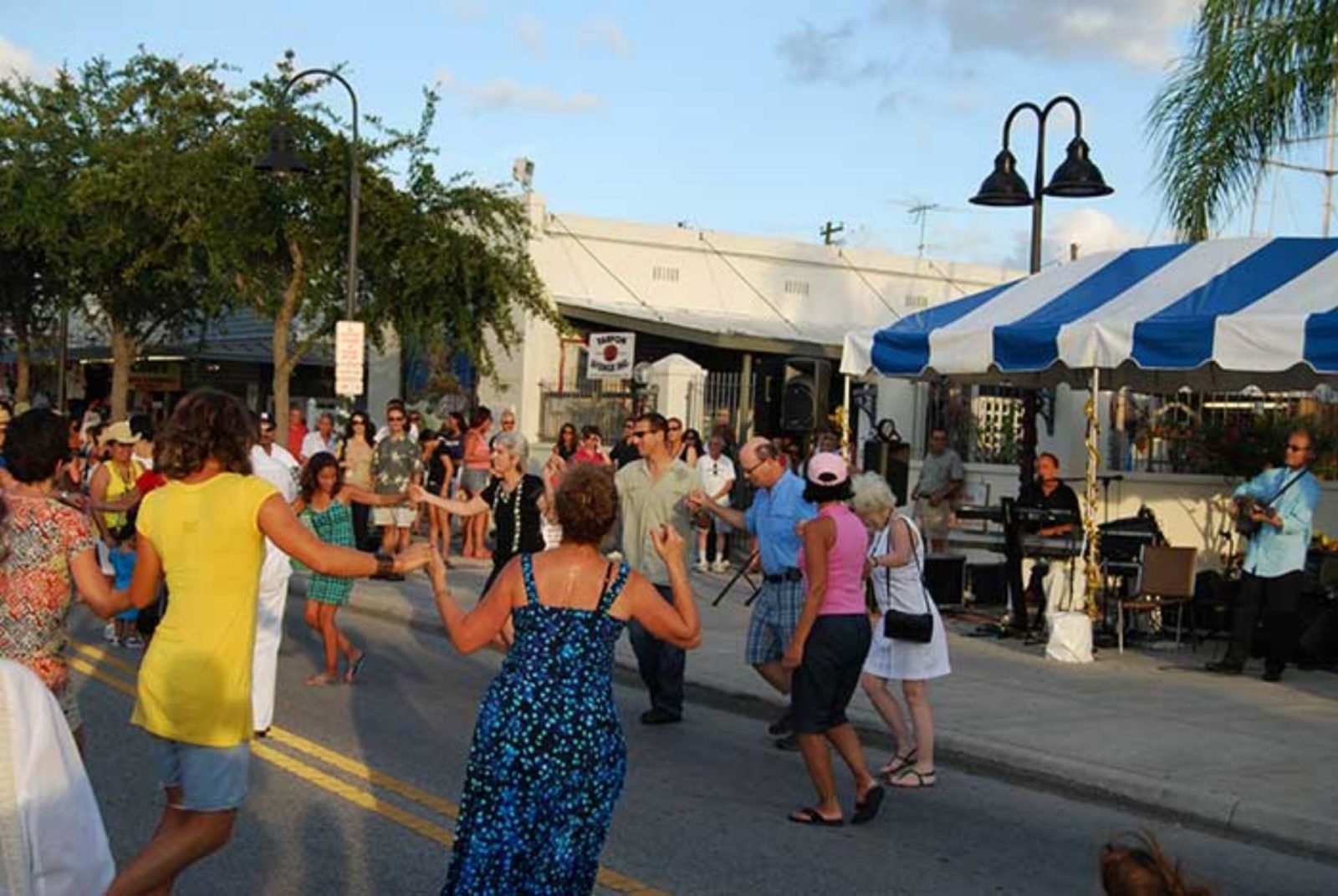
The Greek influence is easy to be found. Photo: Spongenet

In Tarpon Springs itself Eric highlighted the AHEPA House, and the cove where the annual Epiphany Celebration on January 6 is celebrated far and wide; locals of all backgrounds consider it a highlight of their calendar and people come from all over. The maritime focused religious celebration has special reverence and relevance to a community largely made up of Aegean islanders. It has been going on for over a century and in 2006 Ecumenical Patriarch Bartholomew officiated the centennial. The Greek Independence Day parades are also part of the local culture, and Eric is a fixture at such events, either in foustanella or leading Pammachon students in displaying their combat arts for the large crowds. The local high school marching band participates, and Tarpon Springs is known as “Epiphany City USA.”
Eager for another plate of Greek seafood with the loyal companion of choriatiki salata, we repaired to the restaurant across from Mykonos to have a bayou-side meal. Toasting our retsina, a caique motored by, full of tourists and guided by a sturdy Aegean fellow in the classic black Greek fishermen’s hat, which he tipped at our greeting. Then, another coffee at another café right out of a Greek seaside town. Even the waiter’s surliness had a Greek authenticity which made me laugh off my annoyance.
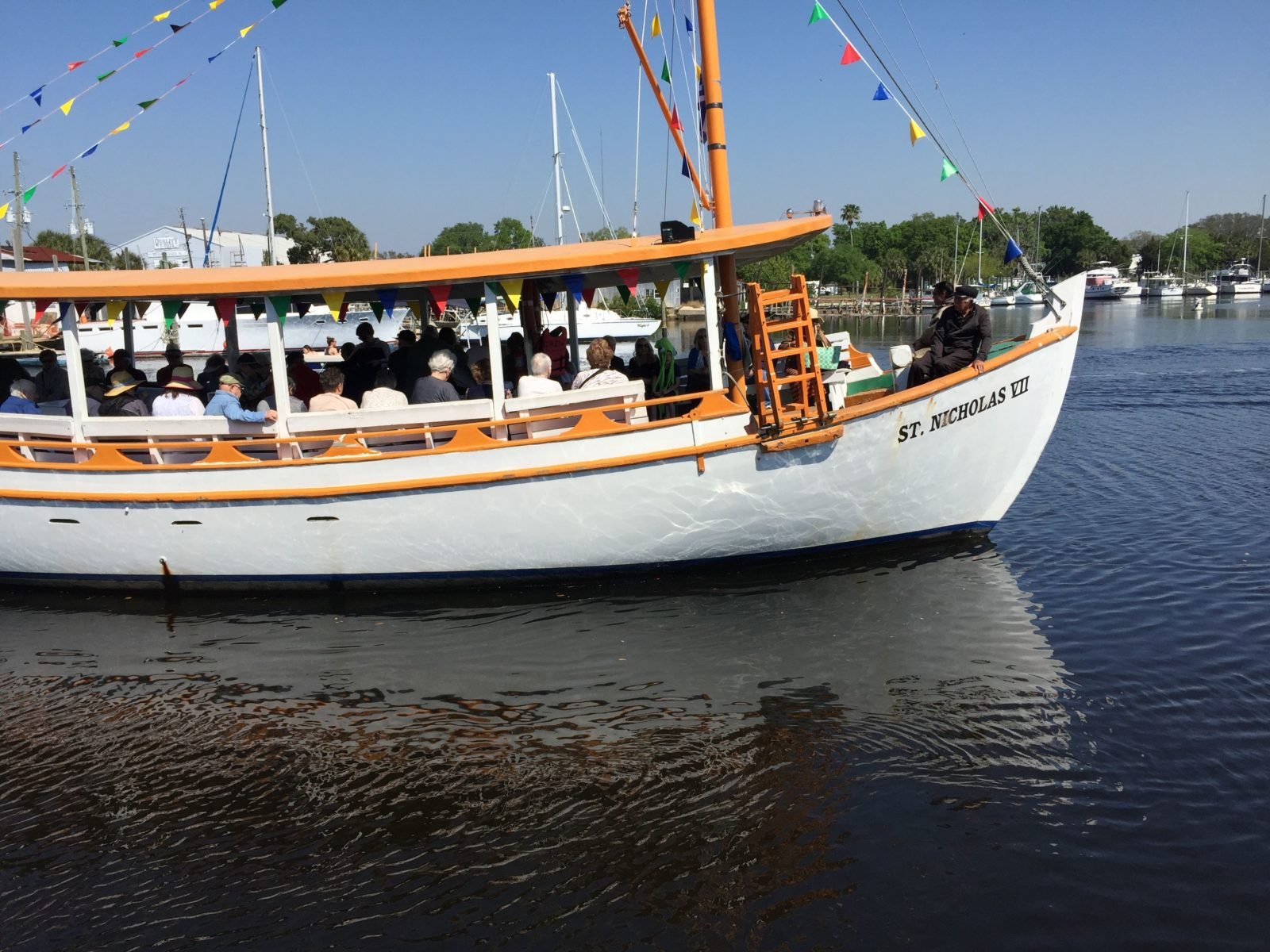
St Nicholas

Coffeed up, Eric started driving again, through the back streets of the town, in a quiet, slightly shabby residential neighborhood. Suddenly a small church appeared made of stone and whitewashed in the timeless Aegean style. The Archangel Michael’s Shrine was built by local Greeks, to celebrate delivery from the perils at sea, and to house a sacred icon brought to Tarpon Springs from the island of Symi. Many miracles have been attributed to the icon and shrine, and after lighting our candles and saying a prayer, upon leaving I touched the masonry of the building, so reminiscent of hundreds of such places I knew in Greece, and a sense of energy and warmth flowed through me and brought me to tears. As often happens in Greece, when leaving a sacred place, I felt a gentle hand guiding me out. Here, in a nondescript section of a Southern town, I felt a sensation never before felt in the New World. This was a real rooted place, and it was very Greek. Many people have been moved or healed by the Shrine, and Ted recalled the Shrine’s guidance in his own life. They named their son Michael.
We then went to nearby Palm Harbor, to see the Cretan Cultural Center, complete with Minoan columns and a map of Crete at the entrance. Here too, in the shaded garden, a venue for countless glendia, there was a chapel, a small testament to the devotion of the builder and the community, again, so typically and utterly Greek. This was not the storefront syllogoi halls of Chicago, New York, Toronto or Melbourne. It was a cultural center of gravity with very local, semirural roots, with all the accoutrements we would find in Greece, but seldom, if ever, in our Diaspora. There was a sense of autochthony here that I never felt anywhere else.
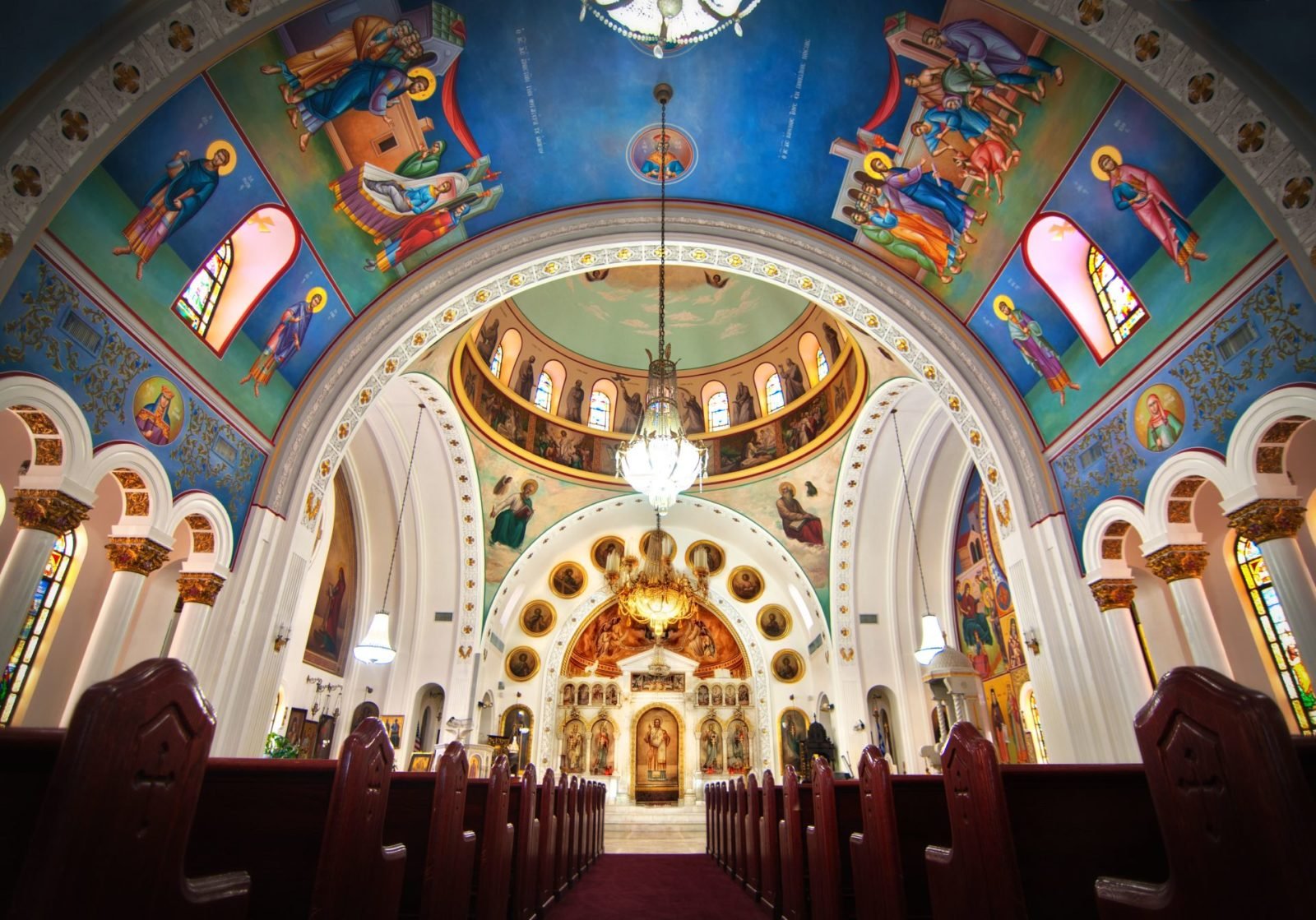
St Nicholas Greek Orthodox Church at Tarpon Springs. Photo: St Nicholas
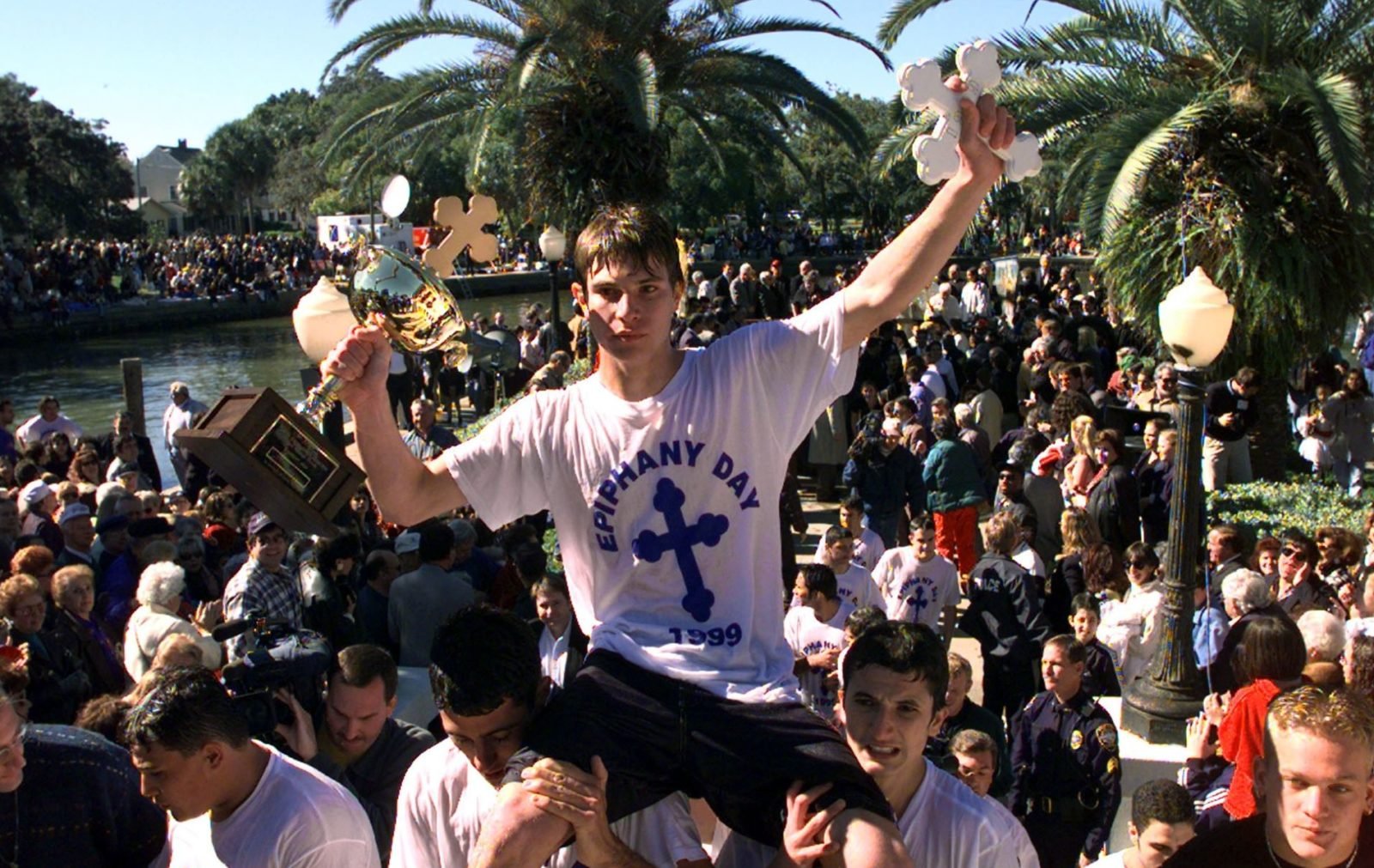
Jason Kolbe, 16, is carried on shoulders from the Spring Bayou after finding the cross during Epiphany Day festivities in Tarpon Springs, Fla. Wednesday, Jan. 6, 1999. Divers aged 16-18, braved the cold weather to try and retreive a cross thrown by Greek Orthodox Archbishop Sypridon. The boy who finds the cross is said to have a year of good luck. Kolbe was among 64 boys who participated in the event. (AP Photo/Chris O'Meara)
We were running behind schedule, as I needed to get back to my hosts to get presentable for my evening lecture, but we had one final stop. On Clearwater Beach, easily one of the finest beaches in America, there stood a statue of Teodoro the Sailor, reputed to be the first Greek who set foot in what would become the United States, back in 1540!
My lecture was on “Byzantium, Hidden in Plain Sight” easily had a turnout of 200 people, the vast majority local people though a few came from Chicago. What struck me about the crowd, in contrast to the number of times I spoke about this same subject in Chicago or New York, was just how local and rooted the audience was, like they just came off the street for the event. It reminded me of a lecture I did many years ago in Rhodes. People arrived either dressed up or dressed down for an event that mattered to them.
One of the most interesting and telling signs of the rootedness, the autochthony of the Greeks in the area, was when a woman came up for me to sign my book she had just purchased. She spoke a mixture of English and Greek that she called Tarponezika (Tarponese). The Greeks had been there long enough, and were distinctive enough, and perhaps, for a time, isolated enough to have developed a Greek of their own, combining the island Greek of their ancestors with the assimilation of Englishisms which all Greeks in Anglophone countries do.
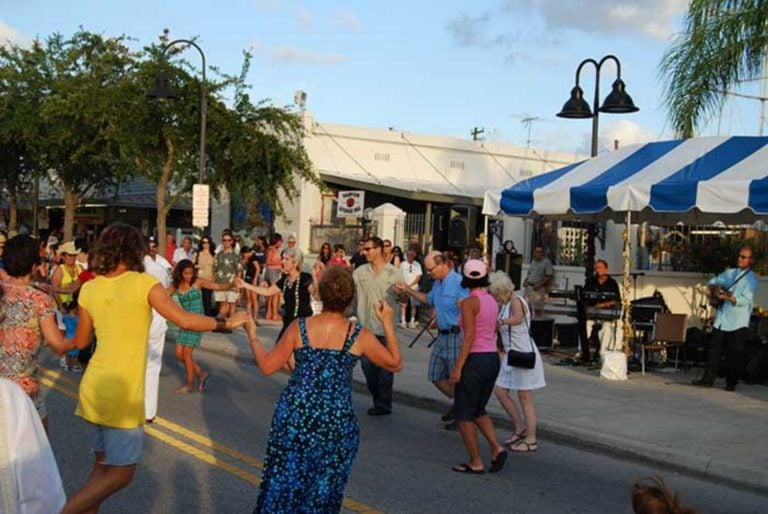
When people would say that Tarpon Springs is like a little spot of Greece in America, I used to scoff, yet going there changed my mind. The people, their monuments, their traditions, their dialect—even their caiques—spoke of a rooted local community that made the place in their Greek image. The charm and beauty of the place, and the very Greek philoxenia found there has not gone unnoticed. The American daily USA Today named Tarpon Springs as the third best small town in the United States for culture in May 2019, and in 2018 the same publication named it the best historic small town in the country.
Greeks, the sea, culture, and history. It’s all here in Tarpon Springs, and it’s real.









